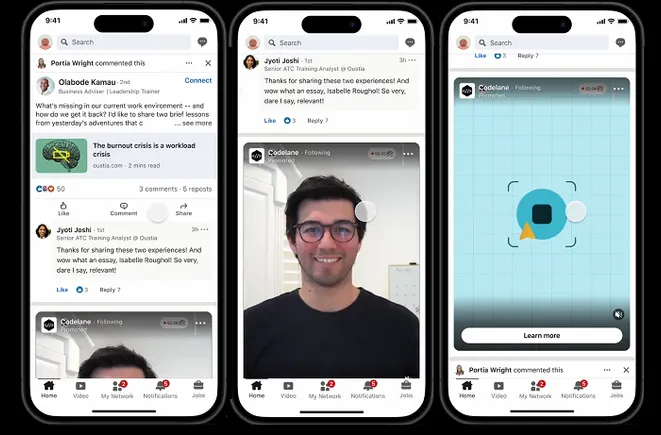How to find your brand’s niche on social media
If you download the Calm app, you’re greeted with an immediately soothing vibe when you open it. Quiet nature sounds play, the interface is Read more... The post How to find your brand’s niche on social media appeared first on Sprout Social.

If you download the Calm app, you’re greeted with an immediately soothing vibe when you open it. Quiet nature sounds play, the interface is designed in soft colors and you can select a variety of meditations, sounds, ASMR or even “Sleep Stories” to help your mind slow down and relax. Yet, if you head over to Calm’s TikTok account, you’ll find something a bit different: chaotic memes, low brow humor and a dash of education around mindfulness and mental health.
It’s part of Calm’s approach to niche marketing. Nearly anyone could use more mindfulness in their life, but Calm knows not every piece of content will resonate with everyone who comes across their account. And that’s the point. The company connects with various niche groups, acknowledging the parts of their lives that are decidedly not calm. They’ve featured videos of moms at a rage room for Mothers’ Day, memes for Gen Z employees who’ve recently entered the corporate workforce and meditation for outdoor enthusiasts.
Niche communities are powerful because of their more exclusive nature. When brands understand the niche interests of their target audience, social media marketing becomes more authentic and impactful. According to the Sprout Social Index™, consumers rank authenticity and relatability as two of the most important characteristics for brand content, and defining your niche as a brand is a way to embody both.
What is a niche on social media?
In the context of social media, a niche refers to a community built around a specific expertise, interest, demographic or other shared characteristics. Niches involve a select subset of a broader audience. For example, instead of targeting women ages 25-40, your fitness brand might be looking for women in this age group who engage in CrossFit communities like #crossfit or #crossfitathome.
Finding your niche as a brand helps you stand out among competitors and the general marketplace. Knowing your niche helps define who you are and what differentiates you. Niches also help build more authentic consumer connections that go beyond a single sale; they tie your brand more deeply to consumers’ everyday lives and interests.
To build those connections authentically, your niche/s should align with your brand’s values and goals as well as those of your audience. Hopping into a niche community that doesn’t resonate with your values will be frustrating at best and reputation damaging at worst. For example, an environmentally-forward brand looking to connect with an audience about clothing trends would probably not be a fit for communities around fast fashion. Lean into what’s most important to your brand to start identifying your niche.
Identify your brand’s strengths to define your niche
To start, revisit core brand tenants like your mission statement and values. What are your non-negotiables, and what impact do you hope to have as an organization?
Also consider your unique selling proposition (USP) for each of your products and services. Note what aspects of your USPs differ from competitors.
Lastly, review your brand guidelines and personality. Are you more upbeat and friendly, or polished with an air of authority? These items together will help create a picture of where you can provide the most value as a brand and what separates you from others in the space.
With this information in hand, conduct a SWOT analysis to identify your brand’s strengths. You may have done one previously as part of your social media audit, but it’s helpful to refresh and see how things have changed. Keep in mind that the Strengths and Weakness portion of the analysis speak to internal factors, and Opportunities and Threats focus on external forces. Use the information you gathered to map out each area. Once you have a good picture, turn your attention to your audience.
Understand your audience’s passions
Take your ideal customer profile (ICP) and identify their demographics and psychographics. With this initial idea, consider questions like:
- Where are they most active on social media? Are they TikTok shoppers or Facebook scrollers?
- How often are they online? And what times of day are they most active?
- How are they using social media? Is it to connect with family and friends, follow influencers, search for answers or ideas, or are they shopping and making purchases?
- Are they using social media for community? If so, is it connected to an IRL community too?
- What type of content resonates with them? What are they looking for from brand social content?
Once you’ve explored these questions, use the answers to draw out your audience’s values, interests and passions. Even their preferred network can speak to certain value systems or beliefs about social media. Based on this, visualize what pain points this audience might have that your brand can solve. What do you offer that can improve their lives based on the values you’ve uncovered?
Find overlapping interests
Next, place your brand identity side by side with that of your audience. There will likely be points of overlap where your brand’s expertise and offerings intersect with the niche interests of your audience.
If you’re a sustainable fashion brand and you discover your ICP contains minimal living enthusiasts, you both likely value the environment and reducing waste. Similarly, a company offering toxin-free cleaning products may resonate with parents focused on holistic care for their growing family. Draw connections between your brand’s values and your audience’s passions to find the relevant niche.
Look from a few different angles to highlight different niches. There are niches communities within:
- Industry-specific topics
- Internet-based communities
- Demographic and geographic segments
- Problem-solution angles (an issue your audience has that your brand can solve)
Sprout’s social team uses social listening alongside what they hear in the Sprout community, The Arboretum, to understand how different industries and roles engage with key topics. Greg Rokisky, Senior Social Media Strategist, says, “Whether we’re looking at our healthcare or financial hubs or comparing what matters to practitioners versus executives, we’re mapping those insights to show up in ways that feel relevant, not one-size-fits-all.”
If it exists, there is likely a niche for it. A social listening tool like Sprout Social can help you validate the niches and overlaps you uncover within your audience by searching conversations related to your brand and industry.
Conduct a competitive analysis
Now that you’ve identified some possible niches your brand fits into, it’s time to get a feel for how similar brands are connecting (or not) with these communities and topics.
Make a list of your brand’s top competitors and start by analyzing if they’re appearing in content posted in the niches you want to target. For example, if you’re looking to tap the FinTok (financial TikTok) community, conduct some influencer research and dig into related hashtags like #PersonalFinance and #DebtFreeLiving. These will help you locate top influencers and content to see if your competitors are participating in conversations there.
If you do find relevant content, review it to see if you can reverse engineer their approach. What type of content is it, and does it have good engagement? Can you discern their goals for the content? If the content doesn’t seem to have high engagement (or if there is no competitor content at all), this could be a gap your brand could fill. Use your research here to inform a thoughtful strategy for your brand in this niche. Sprout’s social media competitive analysis tools, including social listening, can automate parts of the process for you by looking across your key competitors’ social presence and their audience sentiment.
Research relevant keywords
As you research how competitors are showing up in the niche, you can pick out relevant keywords and hashtags your audience is using. Influencer content is a great resource for this as well, as they’ll often use trending hashtags in their posts. Make note of niche hashtags used in conjunction with popular ones, and explore the type of content different hashtags take you to. A bonus: You may discover new SEO keywords to pursue in your broader marketing efforts.
Click through hashtags to discover where conversations are happening. There may be actual groups, like on Facebook, where niche communities are meeting or discussion may be happening in the comments for influencer videos. Wherever they are, these conversations will help spotlight current trends in the niche, give you a feel for how popular it currently is and point to the right social networks.
Select the right social media networks
All of the research you conduct across your audience’s interests, competitor content and relevant keywords will guide you to the best social media networks for your niche. Where your audience is spending the most time engaging with their niche will be the number one driver in selecting which social channels to pursue.
Meeting your audience where they’re is a foundational part of niche marketing. Other networks may also be a good choice if relevant influencers, creators and audiences are building a presence there. For example, some TikTok influencers in niche spaces began building their community on Instagram as well due to uncertainty about access to TikTok in the US.
Choosing the best social media networks for your niche is also based on what types of content perform best with your audience. If they gravitate to videos, TikTok and Instagram are solid choices. If they’re looking for a managed group to participate in, Facebook might be the right choice. Depending on your brand’s strategy for content and what your audience wants to see, you might target a mix of channels or focus heavily on one.
Develop your niche content strategy
Once you have your niche/s nailed down, it’s time to integrate it with your social media content strategy.
Experiment with different types of content tailored to your niche audience. Incorporate testing to validate the interest overlaps you discovered during your brand and audience research. Social media is an excellent platform for A/B testing to see what resonates most. For example, Instagram offers some accounts trial reels, which enable you to test content with non-followers before sharing it with your fans.
Edutainment is a potent form of social content for niche marketing as it adds value while keeping attention. It’s also popular: 66% of social users find edutainment engaging.
Also consider partnering with influencers and creators to build credibility and awareness for your brand. One of the ways Sprout thinks about niche is by matching creators not just to their audience, but to the full context of the activation. Sprout’s Vantage roadshow—an in-person event series—is a great example of this philosophy in action.
“We partnered with two Orlando food creators, since every stop includes a food activation, and brought in a dog influencer for a pet-friendly experience in Chicago. Each creator was sourced using Sprout Social Influencer Marketing to ensure a strong fit. When the environment, audience and creator align, the content doesn’t feel forced—and that’s when it performs best,” Rokisky shares.
Sprout Social Influencer Marketing streamlines influencer sourcing to help you find the creators that best align with your brand. The AI-powered search to help you find the right influencers who are safe for your brand and contextually relevant.
Regardless of the type of content your brand chooses to craft, keep your audience at the forefront. Serving their needs and specific interests is the most important factor.
Build and engage the community
As a brand participating in a niche space, it’s important to remember that you’re a guest unless you have a brand community you oversee. Actively join in relevant conversations in ways that are authentic, transparent and respectful regardless of network or conversation type. You can communicate through comments, direct messages and community posts depending on the network.
One important part of social media community management is to ask questions. These can be simple conversation starters or targeted questions that open the door for candid insight on your brand, thought leadership, products and services that you might not have received otherwise.
Engaging directly with the community through questions and discussion participation is important in building a following over time. Consumers appreciate having access to you, especially when your brand can add value in a particular niche.
Stay relevant with social media listening
As with everything on social, niche communities will evolve over time. Make sure you are informed about the evolving trends in the space. Your audience wants you to be informed: 93% of consumers say it’s important for brands to stay on top of online culture.
Social listening tools will help you stay ahead of conversations and understand audience sentiment. Tracking niche activity with social listening can highlight nuances you may have missed, and help you avoid a brand flub.
Social listening is also valuable for identifying emerging trends. Sprout Social Listening sifts through millions of conversations for you, so you can get to the heart of conversations relevant to your brand and keep up with what’s happening in your niche.
Analyze audience feedback and engagement
Leverage your social listening and engagement data to analyze feedback about your brand. Pay attention to comments, messages and mentions to understand audience preferences and pain points. Whether they’re bringing it to you directly or chatting about it with others in the space, you’ll find valuable insights to help improve your social content and strategy, refine your product or service, and strengthen your brand’s overall marketing approach.
Also track your content’s performance based on KPIs tied to your goals and strategy. You can categorize your niche posts with Sprout’s Tagging to create reports and comparisons with your other campaigns. Knowing what’s resonating (and what’s not) will help you adapt your strategy so you’re staying relevant rather than being a nuisance.
Carve out your social media niche
Your brand brings a unique value to your audience—embrace it! Establishing your niche on social media will connect you to highly engaged audiences who can turn into loyal customers. Be a good community member, and you’ll cut through the noise to stand out as trustworthy and knowledgeable. Start discovering your niche with our market research worksheet to uncover where you and your audience meet.
The post How to find your brand’s niche on social media appeared first on Sprout Social.























![How To Launch, Grow, and Scale a Community That Supports Your Brand [MozCon 2025 Speaker Series]](https://moz.com/images/blog/banners/Mozcon2025_SpeakerBlogHeader_1180x400_Areej-abuali_London.png?auto=compress,format&fit=crop&dm=1747732165&s=beb7825c980a8c74f9a756ec91c8d68b#)
![Clicks Don’t Pay the Bills: Use This Audit Framework To Prove Content Revenue [Mozcon 2025 Speaker Series]](https://moz.com/images/blog/banners/Mozcon2025_SpeakerBlogHeader_1180x400_Hellen_London.png?auto=compress,format&fit=crop&dm=1747758249&s=9f3c5b1b7421f862beace1cb513053bb#)
![How To Create an Integrated Strategy That Increases Brand Mentions and Visibility [Mozcon 2025 Speaker Series]](https://moz.com/images/blog/banners/Mozcon2025_SpeakerBlogHeader_1180x400_JamesH_London.png?auto=compress,format&fit=crop&dm=1747780409&s=9bf9f0a2623b4a8be6eaf8f235115505#)








.png)

















![The 11 Best Landing Page Builder Software Tools [2025]](https://www.growthmarketingpro.com/wp-content/uploads/2024/04/best-landing-page-software-hero-image-1024x618.png?#)






























































![Social media image sizes for all networks [June 2025]](https://blog.hootsuite.com/wp-content/uploads/2023/01/Social-Media-Image-Sizes-2023.png)


![What you're doing wrong in your marketing emails [according to an email expert]](https://53.fs1.hubspotusercontent-na1.net/hubfs/53/jay-schwedelson-mim-blog.webp)

![These AI workflows can 10X your marketing productivity [+ video]](https://www.hubspot.com/hubfs/Untitled%20design%20-%202025-05-29T135332.005.png)






















